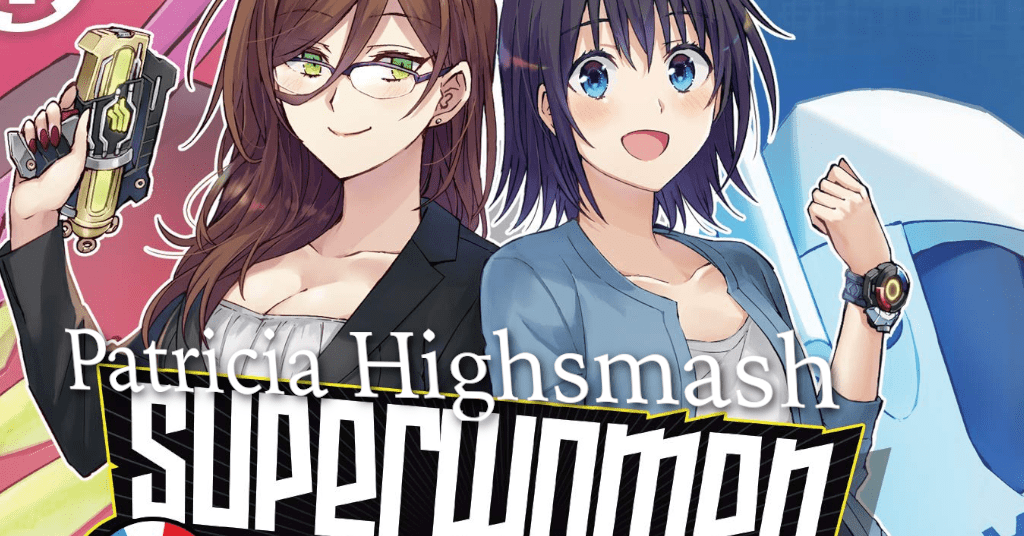Patricia Highsmash
Superwomen in Love!
by Travis Hedge Coke
With thanks to Priya Saxena.
None of the arguments to the effect that queer romance is difficult to have in a superhero comic hold water. If John Ridley, Mikel Janín, Tee Franklin and others can do it, it can, obviously, be done, but also, it can be done as easily, as simply, as doing it. The argument is almost identical to those for how difficult it is to give women something to do in a comic other than pose and be sexy.
I reread, today, a comic written by a smart cishet man, in which the only prominent woman is lounging in a swimsuit on a fake beach in a maximum security prison. The warden laments it makes male guards pass by her cell too often. We always know the excuses are are excuses.
Superwomen in Love! (originally published in Japanese as, ?????????????), has serialized, over the last few years, the romance between a superheroine and supervillain – Rapid Rabbit and Honey Trap, respectively – quickly requiring the villain to change sides. Drawn and written by sometime, Amanda Haley and Mercedes McGarry adapt their comic fluidly, enthusiastically in English.
Superwomen, smartly, uses the (former) supervillain as our introduction to story and world, allowing us to have doubts but also to admire, alongside her, the goodness and positivity radiating from Rapid Rabbit. An inverse of the first novel in Julie Kenner’s Superhero Protector series, in which the heroine’s naive but eager goodness permitted us to enter that world off our good foot but intrigued, by presenting us a naively jaded point of view and opening up the positivity and potentiality, sometime makes her comic instantly welcoming to us.
“It is hard to have queer romance in a superhero story,” may be such a popular statement because, for those saying it, queerness is an intrusion. They will, often, insist that it is romance which intrudes, but inevitably the superhero media that make or which entertains them most is heavy with romance or romantic relationships. Spider-Man was almost primarily a romance story character for twenty years. Even now, the most famous or readily-recalled Spider-Man comics’ stories are not about a particular horror, a special villain, an academic or internal struggle, but interpersonal romantic or familial relationships. The Death of Gwen Stacy. The Wedding of Spider-Man. The Clone Saga is Peter Parker and his clone/brother, his aunt/mom who raised him dying, him running away from his wife and that he struck her while she was pregnant with their child.
Superwomen follows strongly in line with Go Nagai’s Cutie Honey and Steve Ditko’s Amazing Spider-Man, with meet cutes and anxiety being overridden by love and socially inept supervillains and heroes. The co-leads of Superwomen move in together the same day they learn each other’s names and within twenty-four hours of having seen each other’s faces for the first time, because this is a realistic story of real love. They spend the entire moving in period wondering if this is like that or does the other just want to be friends?
Superwomen goes further than the superheroes-with-office-jobs of Spider-Man comics and the cohabitating-sapphics of Cutie Honey, merging all the dynamics into something streamlined and open to fans of tokusatsu superhero, office drama-comedy, and sitcom cohabitation. The evil organization which Rabbit fights against, who fired Honey as a joke she misunderstood as serious (because they did also try to “half kill her”) are unapologetically corporate. The homebound gags are Three’s Company, ky?gen theatre, and traditional quick-digestion manga. These are long, serial stories, but they are quick-digestion serial stories.
Rather than have a work-life, home-life, and super-fights-life, Honey and Rabbit have their lives, because, unlike so many superheroes or villains, they can share every major aspect of their lives together. Queer romance is not taking up space in Superwomen which could be spent on other aspects, because all aspects are queer romance.
Genre formalism is reflexive within the social performances of characters who are genre savvy without them having to believe in a purity or truism to their genres of interest. A character can be embarrassed by the male gaze nature of her work outfit, as a presenter for a superhero show, while also embracing the frilliness and sexiness of the outfit if/when it pleases her girlfriend. Sexuality, uniform, and daily routine cannot be genre-locked or locked by a single gaze, because gaze is not universal and neither is life.
Superwomen indulges in a beachside episode, a longstanding trope of Japanese entertainment usually determinedly cishet man’s purview in which we can all dwell, and in that episode, locks into the arresting, hypnotic nature of sexualized and revealed people (which is simultaneously natural, unposed, and clothed people), instead of bodies. The alternative, in Japanese and American entertainment, is the superhero comic mentioned way up above, and a woman prisoner in a mostly-male prison posed provocatively in beachside-motif; bodies.
Superwomen, by presenting women, refuses to present sexy lampshades or posed body parts. Eroticism is a consistent part of life, but a part of living, autonomous beings.
Emotional integrity buoys us on the hopes of the characters and our hopes which are mirrored in them.
“With love anything is possible! She makes me believe it.”
Other characters can claim that this statement from Honey Trap is hopeless or silly, but it is the thread that ties us to her, to her love, to all of us and all of them.
